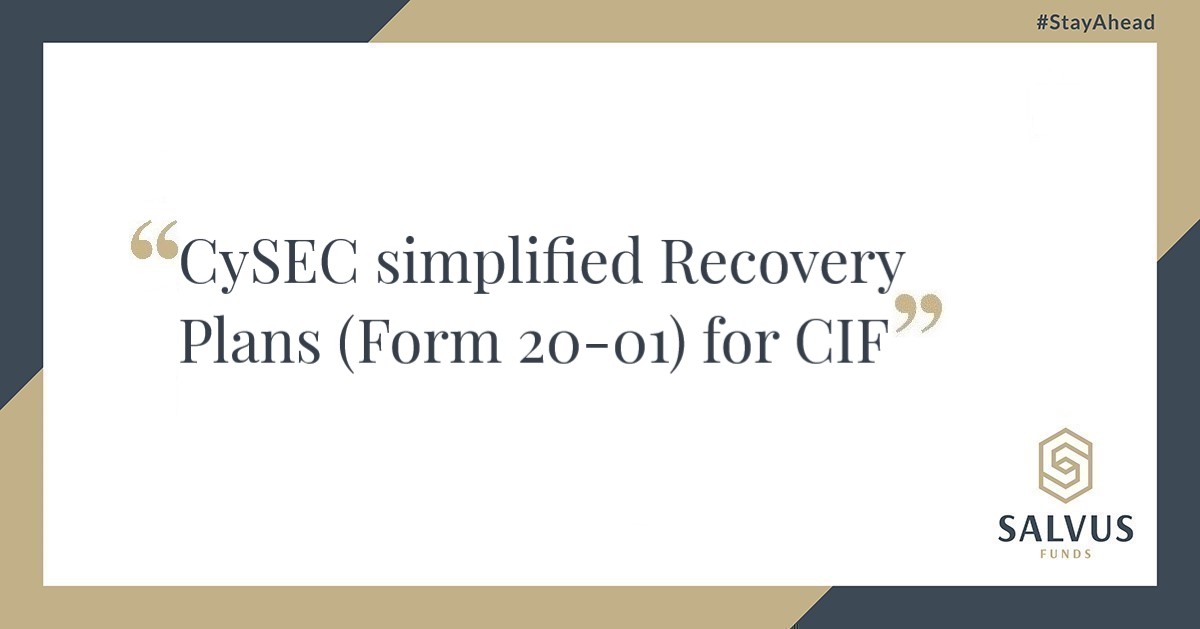CySEC simplified Recovery Plans (Form 20-01) for CIF
The Cyprus Securities and Exchange Commission (CySEC) released Circular C526 to inform the Cyprus Investment Firms (CIF) of common weaknesses and good practices identified during its desk-based review, from sample Recovery Plans (Form 20-01) submitted in 2020.
A CIF which qualifies for the simplified Recovery Plan is required to prepare and maintain a recovery plan that includes as a minimum the information requested by Form 20-01.
A simplified obligation CIF;
- has not been determined as Other Systemically Important Institutions, as per the decision of the Central Bank of Cyprus (CBC) at the time, and
- meets one of the following criteria according to their latest audited financial statements:
- Total assets are less than €1,000,000,
- Total liabilities are less than €1,000,000,
- Total income is less than €100,000,000.
In this context, CySEC highlights significant weaknesses and good practices identified from its desk-based review in order to be taken into account for the preparation of this year’s Form 20-01 and the update of the Recovery Plan. More specifically the weaknesses concern the following areas:
- Governance arrangements – The recovery plan shall clearly indicate the designated roles and each person’s accountability relating to each recovery procedure, along with the escalation process assigned. In this respect, a CIF shall
- identify the exact actions required during the recovery process, the person responsible for each action and their order of execution.
- describe in detail the way that the recovery plan suits the company’s overall risk as this is determined by the management.
- Strategic analysis – In some recovery plans it was observed that a CIF declares specific functions as critical without considering the provisions of the applicable legislation.
- Functions should be determined as critical only after consideration of the criteria defined in Article 6 of the Delegated Regulation (EU) 2016/778.
- Stress scenarios – Under stress testing a CIF shall identify two scenarios, severe enough for the CIF to approach default, taking into consideration its business model.
- The identified scenarios shall clearly indicate the impact on the CIF recovery indicators.
- At least one scenario shall impact the CIF on a stand-alone basis and at least one scenario shall impact the entire financial market and consequently the CIF.
- Scenario stress testing shall be used for evaluating the effectiveness of the CIF recovery plan and the adequacy of its recovery indicators.
- Recovery options – The recovery plan shall present a wide range of feasible recovery options which are able to achieve the required impact within the correct timeframe. For that purpose, recovery options shall
- be presented in detail and provide a clear picture of the expected outcome,
- be decided after the consideration of potential operational and legal barriers,
- provide a realistic timeframe for management actions to deliver the anticipated results,
- derive the capital ratios which indicate the impact on recovery indicators, after the application of recovery options.
Placing the above into perspective and as good practices, CIF entities are invited to:
- identify the core business lines and the risk indicators before proceeding with the testing of stress scenarios.
- examine stress scenarios which are feasible, realistic, and detailed explained, as well as related to their business model.
- provide a clear assignment of roles for each action that is needed within a specific timeline.
- communicate with CySEC about the recovery measures taken, especially during volatile periods where they experience significant financial stress.
As reminded by CySEC preparing, reviewing regularly, and maintaining an up-to-date recovery plan gives CIF the ability to deal effectively with periods of financial distress, recover from potential financial losses and improve further their financial performance.
CIF entities subject to a simplified Recovery Plan must prepare and submit Form 20-01, via CySEC’s Transaction Reporting System (TRS), by the 30th of September 2022. The naming convention of the file must be in the form ‘XX_Year_Form20-01’, where XX corresponds to the CIF identification code and Year corresponds to the reporting year.
The SALVUS Risk Management team can support you with preparing Form 20-01, establishing a Recovery Plan, and the relevant stress test scenarios considering your CIF’s business model.
Do not hesitate to contact us at info@salvusfunds.com or call us at +357 7000 7898 if you require additional information for the preparation of Form 20-01 or fulfilling your Recovery Plan regulatory obligations.
#StayAhead

